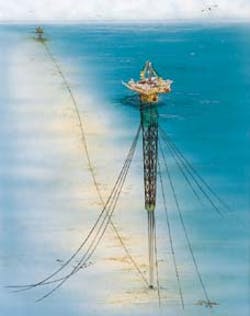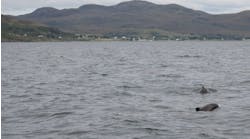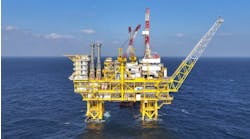Leonard LeBlancBy the year 2000, operators in the US Gulf of Mexico expect to be drilling routinely in water depths exceeding 8,000 ft and occasionally in depths up to 10,000 ft. Years ago, that might not have been much of an geological attraction. Today, geoscientists know that substantial hydrocarbon accumulations exist in that water depth corridor. In fact, other than political restrictions to regional water bodies, ultra-deepwater and the Arctic are the only two frontiers left for offshore exploration.
Houston
Of the 26 drilling vessels that have or will shortly have deepwater capability, only three or four have the capacity to exceed 8,000-ft water depths, and those already have day rates exceeding $120,000 per day with long contracts. In the US Gulf alone, the US government is expected to lease over 100 tracts per year in depths exceeding 8,000 ft by the year 2000. More tracts could be leased if operators had confidence in drilling unit availability.
With this equipment constraint in mind, Spars International (SII) and Deep Oil Technology (DOT) are engineering a spar-shaped drilling unit with seakeeping characteristics superior to all existing mobile drilling units. The design is similar to two previously engineered spar-shaped production vessels for the US Gulf of Mexico: Oryx's unit for Viosca Knoll Block 826 (Neptune) for 1,930 ft water depths, which is now being installed; Chevron's unit in Green Canyon Block 205 (Genesis) for 2,590 ft water depths, which is being fabricated.
The spar drilling unit will be jointly owned by J. Ray McDermott Holdings and Aker Oil and Gas Technology. Aker and McDermott are the owners of SII, which is the exclusive licensee of DOT's spar technology.
Shell Oil, the holder of over 300 leases on eight-year terms in deepwater, critically needs more vessels to exploit its leaseholdings. Shell commissioned McDermott/ Aker to proceed with engineering design a spar platform to be used as a mobile rig. Once the engineering was complete, Shell will evaluate leasing one drilling spar with an option to lease up to two more. Detailed engineering will begin in early 1997, and construction, if approved by Shell, would begin later that year. Delivery would be in 1999.
Stability
Unlike a conventional monohull or semisubmersible drilling unit, the spar-shaped unit will ride deep in the water. That hull depth is what provides excellent seakeeping characteristics and very low drilling downtime waiting on weather. Also, the spar is relatively insensitive to water depth, deckload, and deck arrangement of equipment and modules.
The heave natural period of a spar with a draft of about 600-700 ft is about 30 seconds, higher than compliant towers and far higher than the 12-18 seconds for peak waves. In effect, the spar would pitch with its axis at the spar's keel. The fairleaders for the mooring spread are located at or above the midway point in hull draft to minimize mooring line dynamics.
Also, the center of buoyancy is much higher than the center of gravity. During a 100-year return period hurricane in the US Gulf of Mexico, tests indicate the spar at the center of gravity would experience a maximum surge of 130 ft, heave of four ft, and a mean pitch of 3.33 degrees. More importantly, during eight ft significant wave conditions, which exist 90% of the time, center of gravity conditions include a nine ft surge, zero heave, and a mean pitch of 0.06 degrees.
In exchange for excellent seakeeping qualities, however, the spar drilling unit must give up something in terms of transportability. The unit will be limited to drilling in a certain area for a long period of time. Tow over long distances at a maximum speed of four knots would be very time-consuming.
At the same time, the Drilling Spar can drill both exploration and development wells with little down time in water depths as shallow as 1,000 ft. The 8,000-10,000 ft water depth corridor in the US Gulf of Mexico would be an excellent application of this technology, since it would have a better chance to outperform conventional drilling units. Tows exceeding 100 miles would be rare in the US Gulf.
The McDermott/Aker spar is expected to cost considerably less than the $300 million needed to build a fifth generation semisubmersible for 8,000-10,000 ft depths. The lower cost would keep day rates in the range of vessels with a water depth capability half that of the spar driller.
Configuration
The configuration of the spar drilling hull is that of a deep-draft cylinder, floating vertically, and held on location with a semi-taut catenary mooring system. The unit will draw 650 ft of water, and if needed, a US Gulf of Mexico well in water depths as shallow as 1,000 ft could be drilled.
The spar's motion characteristics provide longer periods of drilling in rough weather. Typically, storms in the US Gulf with 15-25-ft seas and 35-knot winds produce such roll, heave, and pitching motions on the rig-riser-drillpipe linkages on conventional drilling vessels that drilling must be halted. Such a drilling shutdown aboard a spar would be rare. In addition, the riser, which normally takes a beating in the wave zone from high waves on semisubmersible drilling units, would be protected inside the spar. Sea motion inside the spar's centerwell would be minimal.
Unlike the production spars - Oryx's Neptune and Chevron's Genesis units - which feature a fully skirted exterior, the drilling spar features an open truss frame below the buoyant hull. SII/DOT designers maintain the trusswork reduces the steel weight of the hull while preserving the spar's favorable motion characteristics.
Centerwell
Like monohull drilling units but unlike semisubmersibles, the centerwell (moon pool) is completely enclosed within the center of the 110-ft diameter spar driller's cylindrical hull to the depth of the buoyancy tank atop the trusswork. The tremendous depth of the centerwell virtually isolates the water motion inside the centerwell. The riser and rig floor remain in alignment, even in the roughest storms. Since rig-up work on the riser, wellhead, blowout preventers, and other related gear can be conducted at all times in the centerwell area, drilling downtime is reduced substantially.
The protected centerwell accommodates a buoyancy module, which floats independently within the hull. This module directly supports the weight of the 8,000-10,000-ft-long drilling riser, effectively decoupling the motion of the encircling hull from the buoyancy module supporting the risers. While considered important in engineering design, such decoupling has been difficult to obtain in a drilling vessel other than through supporting the riser load with tensioners. According to SII/DOT engineers, the separation adds flexibility to rig operations and greatly simplifies the machinery required for the support of this large weight.
Mooring
The design calls for mooring the spar with a semi-taut, catenary, eight-line system of wire ropes. The eight cables will be piled to the seafloor instead of anchored with traditional embedding devices. The semi-taut catenary system has shorter lines than conventional, soft catenary systems, which results in a smaller diameter mooring circle and a corresponding reduction in lateral offset for the vessel itself due to wave, current, and wind forces.
In addition, a significant benefit in the spar is the location of the fairleaders far down in the hull, which permit a smaller mooring circle in order to constraint hull motions. Even with fairleaders located at the lowest point of the hull on conventional monohull and semisubmersible drilling units, the mooring circle is necessarily large in order to constrain hull motions in very deep water. Even with deep fairleaders, spar designers say the mooring system is relatively easy to install, operate, and relocate.
The truss framework lower hull of the spar driller also provides another benefit. The open truss frame will not impede current flow, which can move at two-three knots in the deepwater US Gulf.
10,000-ft operations
Drilling in 10,000-ft water depths requires equipment that is larger and more robust than any existing today. A larger derrick, higher circulation pressures, greater pumping volumes, and greater onboard storage of muds, pipe, fuel, and chemicals are all required. Higher payloads have to be supported by the buoyancy of the outer hull.
With its cylindrical shape, the spar hull provides economical buoyancy for the steel weight. Because of its large diameter, small increases in hull diameter result in large increases in hull volume and net displacement. The spar drilling unit pays a very small penalty in extra size and steel requirements for deckload capacity, encouraging a rig configuration that includes everything needed to drill the well efficiently with minimum wait-time.
SII/DOT engineers say the spar provides for drilling in unparalleled depths at day rate costs "comparable to those of rigs currently capable of drilling in water depths only half as deep." Future plans for drilling spars including adding long-term testing and early production equipment to the concept where the oil storage capabilities of the full-depth cylinder can be used to good advantage.
The McDermott/Aker drilling spar design uses open trusswork in the lower hull instead of tankage, since storage is not needed.
This interior cross-section drawing of the topsides for a hypothetical spar drilling and production unit shows the configuration of the drillfloor with respect to the production tree deck and the drilling riser buoyancy can below.
This McDermott graphic shows the various production concepts employed and planned with their associated water depths.The spar's mooring system is shown in profile. [56119801.gif - 34.27 K]






